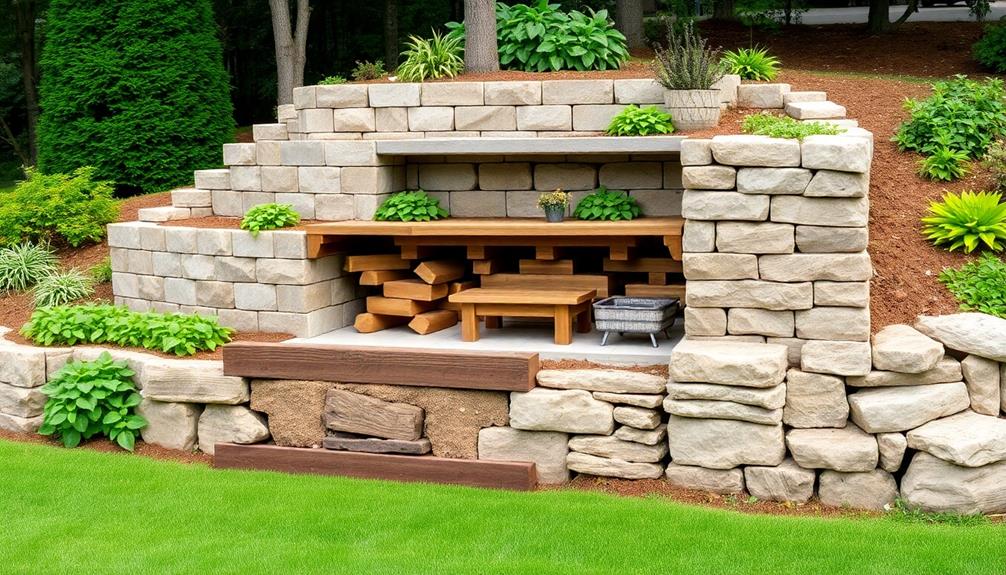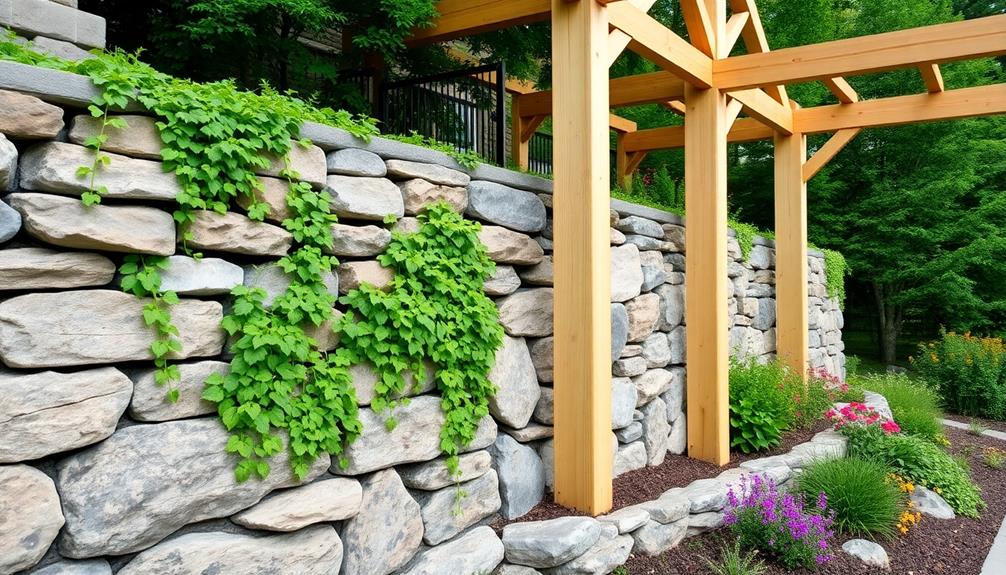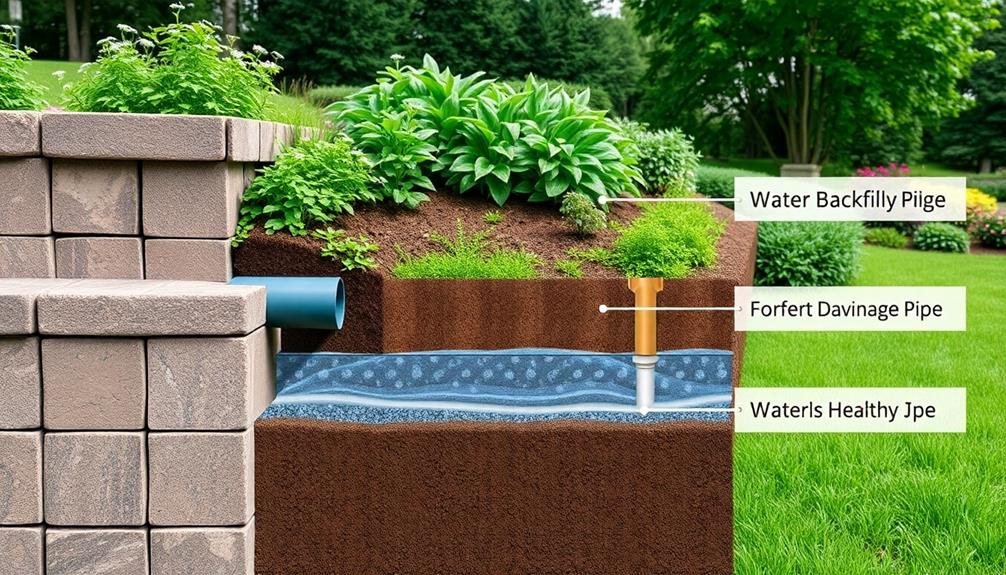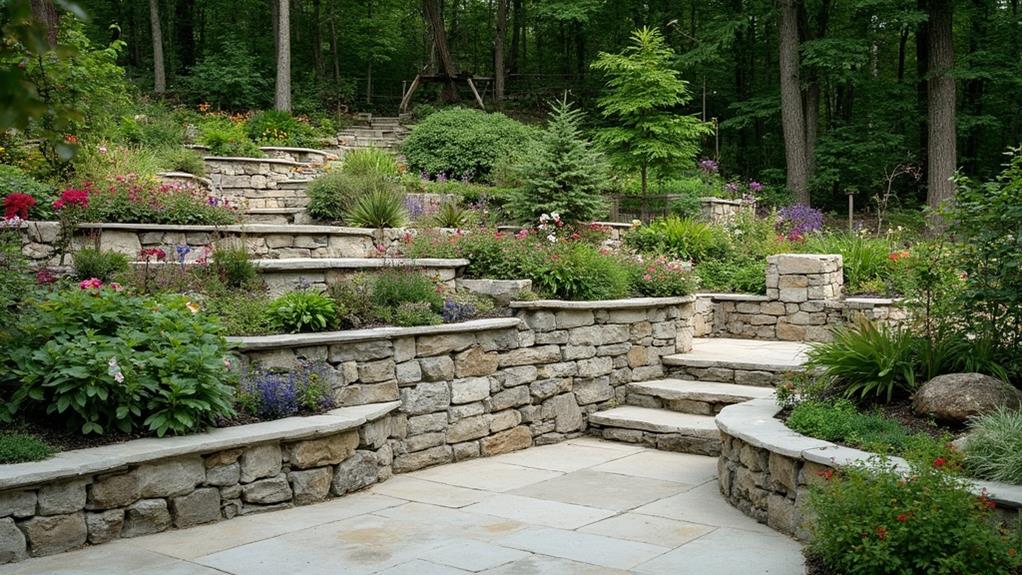When choosing materials for retaining walls, prioritize structural integrity by selecting options like concrete blocks, natural stone, or treated timber, which offer durability and load-bearing strength. Consider aesthetic compatibility to harmonize with your landscape through diverse textures and colors, such as stone or wood that match architectural styles. Assess maintenance requirements, focusing on materials with minimal upkeep, ensuring long-term performance despite climate challenges. Evaluate the environmental impact by opting for sustainable materials that blend with local ecosystems. Finally, perform a cost-benefit analysis to balance initial expenses with longevity, enhancing property value. Explore further to understand the intricate details of perfecting your retaining wall project.
Table of Contents
ToggleWalls Contractor Highlights
- Assess the material's ability to withstand soil pressure, weather conditions, and environmental forces for structural integrity.
- Choose materials that align with the surrounding landscape and architecture for aesthetic and visual appeal.
- Evaluate long-term durability, low maintenance needs, and ease of repair for practical maintenance.
- Opt for eco-friendly and sustainable materials that minimize environmental impact and integrate well with local ecology.
- Consider cost-effectiveness, including initial installation, long-term maintenance, and potential value enhancement.
Definition of Retaining Walls

Retaining walls are structures designed to hold back soil and are integral to landscape architecture and civil engineering, serving the dual purpose of preventing soil erosion and managing water drainage. These walls can also transform unusable spaces into visually appealing and functional areas, supporting gardening, patios, and parking by keeping soil in place and creating usable areas.
The construction and design of these walls require careful consideration of factors such as site topography, load-bearing capacity, and environmental conditions, all of which influence their stability and effectiveness. Material selection is critical, with choices ranging from concrete and stone to timber and steel, each offering unique properties that impact the wall's longevity and performance in various settings.
Purpose and Functionality
A retaining wall serves a dual purpose by both holding back soil and preventing erosion, effectively creating a more usable land area in environments with sloped terrain. These structures are indispensable in transforming challenging outdoor spaces into practical and aesthetically pleasing areas, aligning with the needs of communities that value both functionality and aesthetics. By understanding the purpose and functionality of retaining walls, one can appreciate their contribution to landscape design and earth stabilization.
Primary functionalities include:
- Soil Retention: Retaining walls provide essential support to prevent soil from shifting, which is vital for landscapes located on hills and inclines. By retaining soil, these walls protect structures and vegetation from potential landslides or washouts.
- Erosion Control: An effectively designed retaining wall minimizes the impact of rain runoff, which can erode soil over time. By managing and diverting water flow, these walls help preserve the integrity of a landscape.
- Land Utilization: By leveling uneven terrains, retaining walls create additional flat spaces that can be utilized for a variety of purposes, such as gardens, patios, or driveways, enhancing both usability and aesthetic appeal.
Construction and Design Principles
Understanding the construction-design principles of retaining walls is essential for ensuring both durability and functionality. Retaining walls are engineered structures designed to restrain soil or other granular materials at differing elevations, vital for preventing erosion and managing landscape gradients. A well-constructed retaining wall should seamlessly integrate into its environment while maintaining structural integrity.
Structurally, retaining walls must counteract the lateral pressure exerted by the retained material, which increases with the wall's height and slope steepness.
Key design principles include proper drainage, appropriate foundation depth, and meticulous attention to wall height and thickness. Effective drainage prevents hydrostatic pressure buildup behind the wall, which is liable to compromise its stability. This can be achieved through well-placed drainage pipes and gravel backfill, ensuring excess water is effectively channeled away.
Meanwhile, the foundation must be deep enough to prevent sliding or overturning, tailored to specific soil conditions and climate factors.
Moreover, thoughtfully crafted retaining walls reflect community values, providing a sense of security and belonging by enhancing the aesthetic and functional landscape. By adhering to these core construction-design principles, retaining walls not only serve their practical purpose but also foster a harmonious connection with their surroundings.
Material Selection Criteria
Selecting appropriate materials for retaining walls is an essential step that impacts their durability, efficacy, and aesthetic appeal. The selection process must be thoughtful, considering a blend of practical performance and visual harmony to guarantee the retaining wall not only serves its function but also integrates seamlessly into its environment.
Three core criteria to ponder:
- Structural Integrity: The materials chosen must withstand the pressure exerted by the soil and environmental factors such as water flow and freeze-thaw cycles. Opt for robust materials such as concrete, stone, or reinforced masonry, which offer reliable strength and longevity.
- Environmental Compatibility: It is fundamental to evaluate how well the material aligns with the surrounding landscape. Materials like natural stone or wood may blend better in more organic settings, while urban environments might benefit from the sleek lines of precast concrete or steel.
- Maintenance Requirements: Account for the long-term maintenance needs of the material. Some materials, like treated wood, require regular maintenance to protect against rot and pests, whereas materials like concrete are more maintenance-friendly, needing less frequent upkeep.
Choosing the right materials for retaining walls fosters not only structural soundness but also a sense of connection within the community, valuing both functionality and visual coherence.
Benefits

Retaining walls offer a multitude of benefits, including improved soil stability, which is vital for preventing erosion and maintaining the integrity of landscapes. Boulder walls provide additional advantages as they successfully retain soil on sloped or uneven terrain, offering a sustainable, eco-friendly solution.
Additionally, these structures can greatly enhance the aesthetic appeal of an area by integrating seamlessly with the surrounding environment, offering an opportunity for creative architectural expression. Not only do retaining walls provide increased longevity potential through durable materials, but they also facilitate effective water drainage, thereby reducing hydrostatic pressure and extending the life of the wall itself.
Improved Soil Stability
One of the primary advantages of utilizing retaining wall systems is the enhanced soil stability they provide, effectively preventing soil erosion and landslides. Such stability is fundamental in ensuring that landscapes remain not only aesthetically pleasing but, more importantly, structurally sound, thereby fostering a sense of security for communities.
Constructing a retaining wall can fortify sloped terrain, guarding against the natural yet potentially devastating forces of water and gravity that may otherwise compromise the integrity of your land.
To better understand the benefits of improved soil stability provided by retaining walls, consider the following points:
- Erosion Control: Retaining walls act as barriers to uncontrolled water flow, greatly reducing soil displacement and loss. This function is pivotal in preserving the fertile topsoil needed for vegetation and landscaping.
- Structural Support: These walls provide essential lateral support for near-vertical landscapes, ensuring that soil remains compact and stable even in adverse weather conditions.
- Flood Prevention: By channeling water effectively, retaining walls can mitigate the risks of flooding, consequently protecting both residential and commercial properties from water damage.
Employing robust materials like concrete or stone enhances these features, ensuring the long-term sustainability and reliability of your retaining wall system.
Enhanced Aesthetic Appeal
Beyond their functional advantages, retaining walls can substantially enhance the aesthetic appeal of any landscape. By carefully selecting the materials for construction, retaining walls can transform ordinary outdoor spaces into visually striking environments that invite community interaction and personal reflection. Materials such as natural stone, timber, or concrete blocks offer diverse textural and color options, allowing property owners to align the design of the walls with the architectural style of their homes or the natural elements of their gardens.
The versatile design possibilities of retaining walls enable them to serve as focal points in landscaping projects, seamlessly integrating with plantings, water features, or outdoor living spaces. Through the use of natural or modern materials, retaining walls can introduce an organized beauty to sloped terrain, offering layered spaces that emphasize depth and contours, while promoting a sense of cohesion and unity within the environment.
For those seeking a personalized touch, incorporating lighting into the retaining wall design can dramatically enhance nighttime aesthetics, casting gentle shadows and highlighting architectural features. This not only enriches the visual appeal but also extends the usability of outdoor spaces, fostering an inviting atmosphere that resonates with a desire for a welcoming and harmonious environment.
Increased Longevity Potential
While the aesthetic appeal of retaining walls greatly enhances landscape design, their selection is often driven by the promise of increased longevity. Opting for materials with enhanced durability ensures these structures endure the test of time, providing steadfast support to landscapes. For communities that cherish long-term investment and security in their outdoor spaces, choosing the right materials is indispensable.
Three key factors contribute to the longevity of retaining walls:
- Material Durability: Selecting materials such as concrete blocks, natural stone, or properly treated timber can greatly extend the lifespan of retaining walls. Concrete and stone provide inherent resistance to weathering, while treated timber is resistant to rot and decay.
- Construction Technique: Proper installation using interlocking systems, reinforced ribbing, or geotextile reinforcements can enhance the structural stability of retaining walls. This ensures they remain resilient against earth pressures over time.
- Environmental Suitability: Considering the local climate and soil conditions is paramount. Materials that withstand local environmental challenges, like freeze-thaw cycles or saline conditions, ensure a longer-lasting retaining wall.
Selecting the ideal materials and construction methods not only extends the durability of retaining walls but also fosters a sense of community pride and assurance in shared outdoor environments.
Effective Water Drainage
Properly managing water drainage is an essential factor in the integrity and efficiency of retaining walls. A well-designed drainage system aids in preventing water accumulation within the soil behind the wall, which can lead to hydrostatic pressure—one of the most common causes of wall failure. By facilitating the smooth passage of water away from the wall structure, owners can significantly enhance the stability and durability of their installations.
Additionally, effective water drainage helps to minimize erosion and soil displacement, consequently maintaining the aesthetic and functional aspects of the landscape.
Incorporating drainage features such as gravel backfill, perforated pipes, and weep holes not only helps in alleviating pressure but also contributes to the eco-friendliness of the entire setup by reducing run-off that may lead to waterlogging in surrounding areas. For communities that pride themselves on shared spaces and sustainable living, investing in robust drainage solutions draws collective benefits, ensuring that the lands we cherish remain lush and undamaged by errant water flows.
This attention to detail emboldens the walls to fulfill their intended purpose while coexisting harmoniously with the environment and the community, fostering a sense of security and pride.
Drainage Considerations

Understanding drainage considerations is paramount in the design and construction of retaining walls, as effective systems not only enhance structural integrity but also prevent costly water accumulation issues. Essential drainage systems, such as weep holes and French drains, facilitate the redirection of water away from the wall, thereby preserving the longevity and stability of the structure. By adopting these effective drainage techniques, engineers can mitigate the risks associated with water pressure and potential erosion, ensuring both performance and durability.
| Technique | Function | Benefit |
|---|---|---|
| Weep Holes | Allows water to escape | Reduces hydrostatic pressure |
| French Drains | Channels water away | Prevents soil saturation |
| Gravel Backfill | Provides space for drainage | Enhances water flow efficiency |
| Geotextile Fabric | Separates soil from drainage material | Prevents clogging and erosion |
Essential Drainage Systems
Effective drainage systems are paramount in the construction and maintenance of retaining walls. This necessity stems from the pressure exerted by water accumulation, which can compromise structural integrity. To mitigate such risks, implementing sophisticated drainage solutions becomes pivotal in preserving both the function and longevity of the walls. A thorough approach enables thoughtful integration into existing landscapes, ensuring harmonious coexistence.
A well-structured plan involves several components working synergistically:
- Gravel Backfill: Incorporating a layer of gravel behind the wall allows water to percolate efficiently away from the structure. Opt for the right blend of particle sizes to prevent soil erosion while maintaining effective drainage.
- Drainage Pipes: Installing perforated drainage pipes at the wall's base captures excess water, directing it away from pressure points. This strategy minimizes hydrostatic pressure, enhancing the wall's stability.
- Filter Fabric: Positioning a filter fabric between the soil and gravel prevents the migration of fine particles into drainage systems. This separation ensures long-term effectiveness and aids maintenance efforts.
These elements establish a robust framework, inviting a sense of unity among builders, designers, and homeowners. When each component aligns, the resulting system not only supports the wall's structural aims but also nurtures aesthetic and functional diversity within our landscapes.
Preventing Water Accumulation
Building upon the fundamental integration of drainage systems within retaining walls, attention must now be directed toward preventing water accumulation to further strengthen structural soundness. Water buildup behind retaining walls not only compromises the integrity of the structure but also poses potential longevity issues if not properly managed.
Understanding the threat of hydrostatic pressure is vital, as this pressure can exert force on the wall, leading to possible bulging or failure.
In dealing with these challenges, consideration should be given to the material choices and their ability to facilitate drainage. Selecting materials that inherently allow water to pass through, such as permeable stone or composite materials with integrated drainage features, can mitigate these risks. Additionally, integrating a graded backfill composed of gravel or sand can enhance natural drainage, ensuring water efficiently moves away from the wall.
Beyond material selection, implementing precise regrading of areas around the wall can direct surface runoff accordingly, away from the structure. This involves shaping the landscape to prevent pooling near the wall base and maintaining slopes that guide water safely away, thus preserving both function and appearance. Acknowledging these factors will contribute greatly to the enduring stability of the constructed environment.
Effective Drainage Techniques
Addressing effective drainage techniques is essential for the stability of any retaining wall. Proper drainage alleviates hydrostatic pressure, thereby enhancing the wall's integrity and extending its lifespan. When considering the implementation of effective drainage solutions, one must prioritize materials and methods that successfully divert water away from the wall's structure.
There are several techniques that can be employed to achieve this goal:
- Gravel Backfill: Utilizing gravel backfill behind the wall guarantees that water seeps through, rather than accumulating. This porous medium facilitates water movement and reduces pressure against the wall.
- Drainage Pipes: Installing perforated drainage pipes along the base of the wall allows water to be efficiently collected and guided away. The pipes should be connected to a suitable outlet, such as a storm drain, to prevent waterlogging.
- Weep Holes: Strategically placed weep holes in the wall permit trapped water to escape. Regular spacing guarantees consistent relief from water build-up, minimizing risk of damage.
Selecting the appropriate drainage technique is critical for maintaining both the functional and aesthetic qualities of retaining walls, fostering a sense of security and belonging for all who encounter them.
Walls Contractor FAQ
How Do Different Climates Affect the Longevity of Retaining Wall Materials?
Different climates drastically impact the lifespan of retaining wall materials. Moisture, freeze-thaw cycles, and extreme temperatures can weaken structural integrity. Selecting climate-resistant materials guarantees durability, fostering trust and belonging within the community relying on lasting infrastructure solutions.
What Maintenance Is Required for Various Retaining Wall Materials?
Evaluating maintenance needs involves understanding material-specific requirements: concrete may necessitate crack inspections, while wood demands treatments to prevent rot. Regular monitoring fosters a community of proactive enthusiasts dedicated to preserving structural integrity and aesthetic quality.
Are There Sustainable or Eco-Friendly Material Options Available for Retaining Walls?
Certainly, numerous sustainable and eco-friendly material options for retaining walls exist. These include recycled concrete, reclaimed wood, and natural stone. Incorporating these materials not only reduces environmental impact but also fosters a sense of community and shared responsibility.
How Does the Cost of Materials Impact the Overall Budget for Retaining Wall Construction?
Material costs markedly influence the overall budget of retaining wall construction, affecting affordability and project scope. Choosing cost-effective, quality materials allows communities to allocate funds efficiently while achieving structural integrity, fostering a sense of shared responsibility and accomplishment.
What Are the Aesthetic Considerations When Choosing Materials for Retaining Walls?
Aesthetic considerations for retaining walls involve the desired visual harmony with surrounding landscapes, architectural styles, and personal preferences. Choosing materials with complementary textures, colors, and finishes fosters a cohesive design, enhancing the sense of community and belonging.







